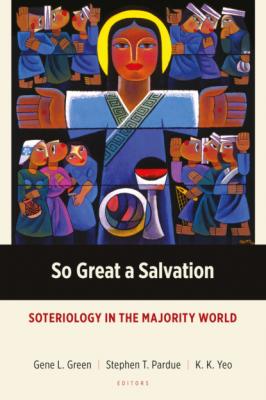ТОП просматриваемых книг сайта:
So Great a Salvation. Группа авторов
Читать онлайн.Название So Great a Salvation
Год выпуска 0
isbn 9781783683802
Автор произведения Группа авторов
Жанр Религия: прочее
Серия Majority World Theology Series
Издательство Ingram
Verses 15–22 indicate that repentance is vital to the promised restoration and the new reality it brings. Colin Gunton helps to explain what is at stake: God’s saving renewal of creation—as full-orbed as it will be—must begin by addressing sinful humanity because our misdirected and aggregated wills are the crux of the problem.[35] We are those who turn God’s good creation into a source of idols, whose idolatry warps human cultures into systemic bearers of injustice and manifestations of broken relationships, and whose fearful and rapacious self-interest harms all that God lovingly made.
Back to Jeremiah 31, God shows particular interest in the disadvantaged according to verses 25–26, where weary laborers are promised refreshment. The fecundity and flourishing of people and animals in verses 27–28 are not inimical to the personal accountability in verses 29–30. For the new covenant in verses 31–34 makes people right with God and new on the inside, inaugurating the covenant community and creation’s full healing. God appeals to creation in verses 35–37 as the reassuring basis of promised restoration: As surely as God lovingly made and sustains all things, so God promises to make the people new. Whatever the debated ecclesiological and eschatological implications, hope of new covenant restoration for the covenant people takes physical form in a remade, ever sacred city of Jerusalem.
Conclusion
Even this brief overview of Jeremiah 31 underscores that the new covenant context of new creation should be more prominent than Western soteriologies suggest. Many recent biblical debates and traditional dogmatic concerns over personal justification and sanctification still have a significant place in that framework. But then we can distinguish their initially prominent, even somewhat central, dogmatic place from their becoming so central that they exclude other soteriological concerns as rivals. The communal and cosmic dimensions of God’s new covenant promises integrate Pauline theology and the rest of the New Testament more holistically. Attention to the new covenant further means reckoning with the Old Testament Scriptures, and thus Israel’s identity and hope, more adequately.
One way of engaging the Majority World perspectives reflected elsewhere in this volume goes beyond framing them merely in terms of alternative concepts, differing contexts, and critique of or even opposition to dominant Western patterns. All of those elements may be prominent. Yet Majority World accounts often provide examples of the narrative theology for which Western intellectuals have been calling—but with rather modest results of their own. By contrast, other chapters in the present volume frequently provide narrative density to problematic Western readings of the Bible—both those that have been directly colonizing and others that have myopically produced unintended consequences. At minimum, Majority World theologies put problematic aspects of dominant traditions under a narrative searchlight that can also highlight alternative ways of engaging biblical soteriology. At maximum, Majority World theologies raise challenging questions about the very conceptual forms dominating Western traditions, given their systematic aspirations. And Majority World theologies help us to imagine more concretely what the fullness of salvation might look like in particular human lives, communities, and local contexts.[36]
The communal and cosmic dimensions of the biblical hope for a new creation underscore not only the context for salvation’s personal dimensions and their complementary divine promises, but ultimately the fullness of Christian hope. They force us to reckon with the plight of so many people and other creatures in God’s world—neither indulging in self-justifying escapism, nor despairing of change, nor arrogating to ourselves another gospel of human making. God has promised a new creation starting with a new humanity—and that renewal begins with my own heart. But it does not end there: God renews my heart not only to receive forgiveness, return loving worship, and bear grateful witness. This renewal also frees me from bondage—to my idolatrous self and other powers—so that I may learn to love all my neighbors and thereby participate in the healing of all creation.
Further Reading
Catechism of the Catholic Church. Washington, DC: U.S. Catholic Conference, 1997.
Demarest, Bruce. The Cross and Salvation. Foundations of Evangelical Theology. Wheaton, IL: Crossway, 1997.
Hill, Charles E., and Frank A. James III, eds. The Glory of the Atonement: Biblical, Theological, and Practical Perspectives. Downers Grove, IL: IVP, 2004.
Luther, Martin. The Bondage of the Will. Translated by J. I. Packer and O. R. Johnston. Old Tappan, NJ: Revell, 1957.
McCormack, Bruce L., ed. Justification in Perspective: Historical Developments and Contemporary Challenges. Grand Rapids: Baker Academic, 2006.
McKnight, Scot. The King Jesus Gospel: The Original Good News Revisited. Grand Rapids: Zondervan, 2011.
Oden, Thomas C., ed. The Justification Reader. Grand Rapids: Eerdmans, 2002.
Stackhouse, John G., Jr., ed. What Does It Mean to Be Saved? Broadening Evangelical Horizons of Salvation. Grand Rapids: Baker Academic, 2002.
Stott, John R. W. The Cross of Christ. Downers Grove, IL: IVP, 1986.
Tidball, Derek, David Hilborn, and Justin Thacker, eds. The Atonement Debate: Papers from the London Symposium on the Theology of Atonement. Grand Rapids: Zondervan, 2008.
Конец ознакомительного фрагмента.
Текст предоставлен ООО «ЛитРес».
Прочитайте эту книгу целиком, купив полную легальную версию на ЛитРес.
Безопасно оплатить книгу можно банковской картой Visa, MasterCard, Maestro, со счета мобильного телефона, с платежного терминала, в салоне МТС или Связной, через PayPal, WebMoney, Яндекс.Деньги, QIWI Кошелек, бонусными картами или другим удобным Вам способом.

